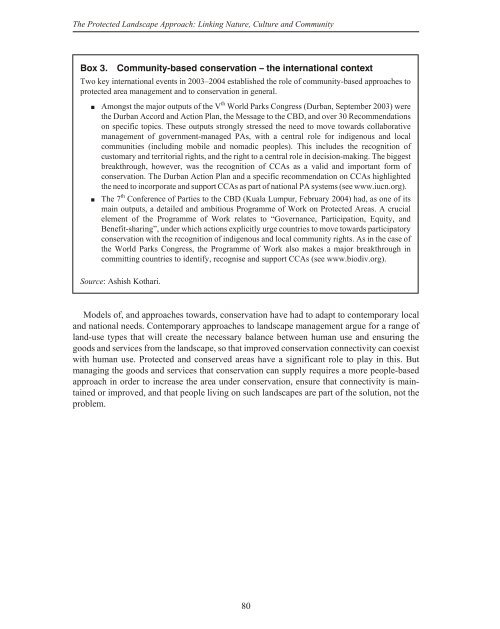The Protected Landscape Approach - Centre for Mediterranean ...
The Protected Landscape Approach - Centre for Mediterranean ...
The Protected Landscape Approach - Centre for Mediterranean ...
You also want an ePaper? Increase the reach of your titles
YUMPU automatically turns print PDFs into web optimized ePapers that Google loves.
<strong>The</strong> <strong>Protected</strong> <strong>Landscape</strong> <strong>Approach</strong>: Linking Nature, Culture and Community<br />
Box 3.<br />
Community-based conservation – the international context<br />
Two key international events in 2003–2004 established the role of community-based approaches to<br />
protected area management and to conservation in general.<br />
<br />
<br />
Amongst the major outputs of the V th World Parks Congress (Durban, September 2003) were<br />
the Durban Accord and Action Plan, the Message to the CBD, and over 30 Recommendations<br />
on specific topics. <strong>The</strong>se outputs strongly stressed the need to move towards collaborative<br />
management of government-managed PAs, with a central role <strong>for</strong> indigenous and local<br />
communities (including mobile and nomadic peoples). This includes the recognition of<br />
customary and territorial rights, and the right to a central role in decision-making. <strong>The</strong> biggest<br />
breakthrough, however, was the recognition of CCAs as a valid and important <strong>for</strong>m of<br />
conservation. <strong>The</strong> Durban Action Plan and a specific recommendation on CCAs highlighted<br />
the need to incorporate and support CCAs as part of national PA systems (see www.iucn.org).<br />
<strong>The</strong> 7 th Conference of Parties to the CBD (Kuala Lumpur, February 2004) had, as one of its<br />
main outputs, a detailed and ambitious Programme of Work on <strong>Protected</strong> Areas. A crucial<br />
element of the Programme of Work relates to “Governance, Participation, Equity, and<br />
Benefit-sharing”, under which actions explicitly urge countries to move towards participatory<br />
conservation with the recognition of indigenous and local community rights. As in the case of<br />
the World Parks Congress, the Programme of Work also makes a major breakthrough in<br />
committing countries to identify, recognise and support CCAs (see www.biodiv.org).<br />
Source: Ashish Kothari.<br />
Models of, and approaches towards, conservation have had to adapt to contemporary local<br />
and national needs. Contemporary approaches to landscape management argue <strong>for</strong> a range of<br />
land-use types that will create the necessary balance between human use and ensuring the<br />
goods and services from the landscape, so that improved conservation connectivity can coexist<br />
with human use. <strong>Protected</strong> and conserved areas have a significant role to play in this. But<br />
managing the goods and services that conservation can supply requires a more people-based<br />
approach in order to increase the area under conservation, ensure that connectivity is main -<br />
tained or improved, and that people living on such landscapes are part of the solution, not the<br />
problem.<br />
80

















